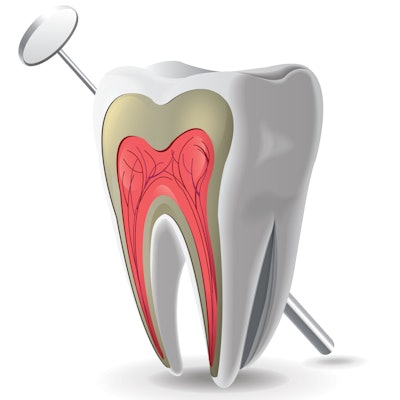
When it comes to examining images of a tooth and identifying a crack, should you use periapical radiography or cone-beam CT (CBCT)? Also, who is better trained to identify these cracks on images, an endodontist or a radiologist?
Researchers from China noted that cracks in teeth present practitioners with a challenge in designing a treatment plan. Using both periapical radiography (PR) and CBCT, they investigated the best imaging method to identify these cracks while also comparing the performance of different practitioners (PLOS One, January 4, 2017).
"In clinical practice, it is a huge challenge for endodontists to know the depth of a crack in a cracked tooth," the authors wrote.
The study was led by Shuang Wang of the department of endodontics at the school of stomatology at Tianjin Medical University.
Sensitivity of diagnosis
“In clinical practice, it is a huge challenge for endodontists to know the depth of a crack in a cracked tooth.”
Early enamel cracks have no obvious symptoms and may not be visible on examination. Yet they can lead to patients coming to your office because of pulpitis, periapical periodontitis, or even root fracture. As creating an appropriate treatment plan and assessing the long-term prognosis for these teeth can be difficult, there's a need to understand the best way to diagnose this condition.
The authors wanted to compare the use of periapical radiography versus CBCT for determining the extent of the crack using an artificial simulation model, in addition to determining whether an endodontist, radiologist, or endodontal graduate student was better able to diagnose these cracks.
Artificial cracks of different extents were created in 44 teeth. The teeth had images taken with both radiography (Dentsply Sirona) and CBCT (Kavo 3D exam, Kavo). The authors used a microcomputed tomography (micro-CT) system (SkyScan 1174 v2, Bruker [formerly SkyScan]) to measure and record the crack depth. The presence or absence of cracks with radiography and CBCT were recorded.
The authors reported statistically significant differences in sensitivity among the three different observers, as shown in the table below.
| Sensitivity of CBCT vs. radiography for teeth cracks | ||
| CBCT | Radiography | |
| Graduate student | 77.27% | 22.73% |
| Endodontist | 81.81% | 8.19% |
| Radiologist | 88.64% | 11.36% |
They also concluded that the results of CBCT and periapical radiography were not consistent in diagnosing cracks by the graduate student, endodontist, and radiologist. The radiologist was able to discern cracks in teeth using CBCT at a lower minimum depth, as shown below. However, using periapical radiography, there was little difference between practitioners. The authors reported that, on the principle that early diagnosis is better, it would be better that radiologists diagnose cracked teeth with CBCT.
| Minimum depth at which cracks were detected | ||
| CBCT | Radiography | |
| Graduate student | 3.20 mm | 6.12 mm |
| Endodontist | 2.06 mm | 6.94 mm |
| Radiologist | 1.24 mm | 6.94 mm |
Based on the higher sensitivity numbers, the authors concluded that CBCT is superior to periapical radiography for teeth cracks. Also, it's better for a radiologist to diagnose a cracked tooth, they wrote.
CBCT more accurate
Another recently published study reported that CBCT scanners were more accurate in diagnosing external cervical resorption lesions than periapical radiography, and that there can be differences between operators when using CBCT versus radiography (Journal of Endodontics, January 2017, Vol. 43:1, pp. 121-125). A 2016 study in the Journal of International Society of Preventive and Community Dentistry (August 2016, Vol. 6:Suppl 2, pp. S93-S104) reported overwhelming evidence that CBCT is a preferred method for detecting vertical root fractures, compared with radiography.
The authors of the current study listed three limitations to their research, including that it was done with simulation models of cracked teeth. They also noted there were no alveolar bones, periodontal membranes, dental pulp tissue, or adjacent teeth to be taken into account, which can influence readings. In addition, the sample size was relatively small and lacked validation with clinical data.
"Within the limitations of this study, on an artificial simulation model of cracked teeth for early diagnosis, we recommend that it would be better for a cracked tooth to be diagnosed by a radiologist with CBCT than PR," the authors concluded.



















